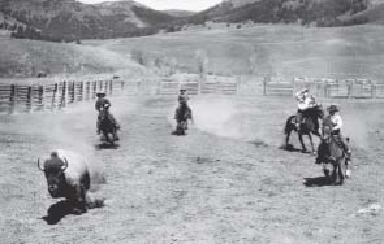Travel Reference
In-Depth Information
Four cowboys rounding up a bison in the Buffalo Ranch corral in 1935, by Jack Haynes.
Wolves lived here at the park's founding but were systematically exterminated as un-
desirable predators. In the mid 1990s a few Canadian wolves were brought to the park,
some of them to an acclimatization pen located on Rose Creek, just a mile or so above the
Yellowstone Institute cabins.
In the valley, you're still more likely to see a coyote than a wolf. Wolves will kill coyotes
that are competing for food, and when the wolves were reintroduced, they began to make
an immediate difference in the park's coyote population. Coyotes may be almost anywhere
at almost any time of day, hunting small prey and foraging for carrion. They have little fear
of man and may attack people if habituated to them.
There's more about all these animals in the Living Things chapter.
Special Caution:
Do not feed any animals in the park. It can be dangerous for you and for
them.
19.3/9.3 Lamar Valley view.
If you're traveling toward the Northeast Entrance along the
main road, you have a long, beautiful view here of nearly 20 miles up the valley to Saddle
Mountain and other peaks in the Absaroka Range near the eastern boundary of the park.
Several miles beyond Saddle Mountain is a remote area first described by Superintendent
Norris after he explored it in 1880; he named it Hoodoo Basin.
Haynes Guide
described “tall,
massed eroded rock pinnacles, which reveal to those who let loose their imaginations a large
variety of forms of humans and beasts.” (See “What's a Hoodoo?”
page 158
.)
20.8/7.8
East end of
Lamar Canyon.
In 1885, Historian Hiram Chittenden described Lamar
Canyon's many boulders as “almost spherical in shape, and, in many instances … as smooth


